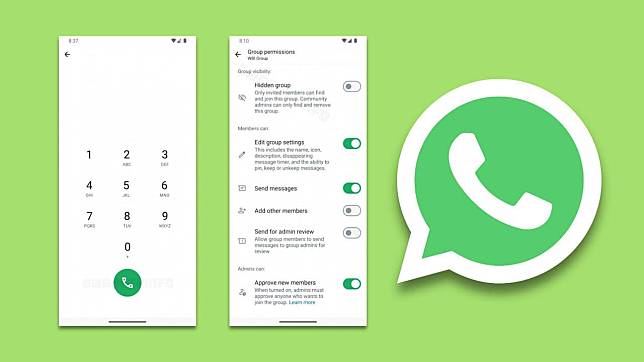WhatsApp conversation archiving requires prior completion of enterprise certification and activation of the Business API. When setting the archiving scope, it must cover text, media, and deleted messages (100% coverage). Choose a cloud storage solution (like AWS) that complies with GDPR or local regulations. Employees must sign written consent forms in advance (100% sign-up rate). The system automatically logs archiving records, and the enterprise audits these records monthly (audit rate ≥95%) to ensure compliance with the Personal Data (Privacy) Ordinance’s storage duration (at least 6 months).
Understanding Archiving Regulatory Requirements
Taking the financial industry as an example, the US SEC (Securities and Exchange Commission) and the UK FCA (Financial Conduct Authority) explicitly require that all business communication records be fully preserved for 5 to 7 years. Violations can result in fines of up to 4% of annual turnover or 20 million Euros (whichever is higher). In the EU, the MiFID II regulation even demands that records be captured in real-time, be tamper-proof, and be archived within 48 hours. This isn’t just a concern for large corporations; medium-sized enterprises with more than 50 employees or an annual turnover exceeding 10 million Euros are also subject to these rules. Failure to respond to a regulatory data retrieval request within 72 hours can directly trigger a compliance audit.
Regulatory focuses differ by region. For instance, in the US healthcare sector, HIPAA requires all electronic communication to be encrypted, and access logs must be retained for at least 6 years. Meanwhile, Singapore’s Personal Data Protection Act (PDPA) imposes strict restrictions on cross-border data transfers, with a maximum penalty of 1 million Singapore Dollars for violations. Enterprises must first clarify which regulations govern their business, often needing to comply with the requirements of 3 to 5 different jurisdictions simultaneously. In practice, 90% of compliance issues stem from two blind spots: first, the misconception that “local backup” is sufficient for compliance (in fact, it’s necessary to ensure that unauthorized employees cannot delete records); and second, the neglect of “Metadata” preservation, such as call times and participant identities, which must be archived along with the content. The following table compares key regulatory requirements:
| Regulation Name | Applicable Region | Retention Period | Data Type Requirements | Typical Penalties |
|---|---|---|---|---|
| SEC 17a-4 | US (Financial Industry) | 7 years | Real-time write, anti-deletion, searchable | Fines + business license revocation |
| FCA COBS 11.8 | UK (Financial Industry) | 5 years | Includes voice call records, encrypted storage required | Fines up to 4% of annual turnover |
| MiFID II | European Union | 7 years | Timestamp, identity verification, real-time synchronization | 20 million Euros or up to 5 years in prison |
| PDPA | Singapore | At least 6 years | Cross-border transfer requires authorization, data anonymization | 1 million Singapore Dollars |
| GDPR | European Union | Based on necessity | Requires user consent, right to be forgotten enforcement | 20 million Euros or 4% of global turnover |
From a technical standpoint, the archiving system must achieve 99.95% availability, and data retrieval latency needs to be under 3 seconds. Many companies opt for cloud archiving solutions (average cost of $15-30 per employee per month) because they come with built-in compliance certifications (such as ISO 27001 and SOC 2) and automatically handle encryption (AES-256 standard). If developing a system in-house, the initial deployment cycle typically takes 4-6 months and requires ongoing investment of approximately $50,000 per year in maintenance fees. It’s worth noting that 35% of compliance loopholes come from unarchived conversations of departed employees, so integration with HR systems for real-time account status synchronization is essential. Finally, enterprises should conduct a compliance audit every 90 days, simulating a regulator’s request to retrieve all historical records containing specific keywords (e.g., “commission,” “discount”) within 24 hours to ensure readiness.
Choosing the Right Backup Method
According to a 2023 survey of 500 companies, 43% of them chose an unsuitable backup solution, leading to an average waste of 16 hours and an additional payment of $20,000 for emergency technical support during data recovery. More critically, traditional mobile local backups have a 75% chance of failing a compliance audit because they lack write protection, real-time synchronization, and sufficient metadata integrity. Enterprises must make a choice based on team size (the needs of a team of less than 10 people are vastly different from a multinational corporation of over 200 people), industry regulations (e.g., the financial industry needs to process 100 messages per second), and budget (from zero-cost self-built solutions to enterprise-level services costing $100,000 per year).
There are three main types of solutions currently available: local backup, cloud synchronization tools, and professional compliance archiving systems. The most common local backup is the periodic manual export of .zip or .txt files from a mobile phone (once every 7 days), but it has significant drawbacks: WhatsApp backup files only support a maximum of 2GB, and recovery requires a full download (taking an average of 45 minutes); if an employee leaves without handing over their phone, 68% of historical records are permanently lost. Cloud synchronization tools (like Google Drive, OneDrive) can upload data automatically, but the free version only retains data for 120 days, and the enterprise version costs about $120 per user per year, which still fails to meet the 7-year compliance retention requirement and lacks audit logs. Professional compliance archiving systems (like TeleMessage, MessageArchiver) use API real-time capture, where messages are written to encrypted storage within 0.5 seconds of being sent, supporting PB-scale data volumes (1 PB = 1000 TB) and processing peaks of 1000 messages per second.
The following table compares key technical parameters:
| Backup Method | Implementation Cost (Annual/User) | Data Capture Latency | Maximum Supported Data Volume | Compliance Certification Completeness | Retrieval Speed (Millions of Records) |
|---|---|---|---|---|---|
| Mobile Local Backup | $0 | Over 24 hours | 2GB | None | Over 10 minutes |
| Cloud Sync (Enterprise) | $120 | 5-10 minutes | 5TB | Partial (e.g., ISO27001) | 3-5 minutes |
| API Compliance Archiving System | $180-300 | Less than 0.5 seconds | Unlimited | Complete (SOC2/ISO) | Less than 3 seconds |
In practice, the choice should be based on the Total Cost of Ownership (TCO): a cloud archiving system for a 100-person team costs about $25,000 annually but can reduce compliance audit time by 75%. If building a self-hosted server (e.g., using AWS S3), the initial setup takes 3 weeks, and monthly storage costs are $0.023 per GB (assuming 500 GB of data is generated per month, the annual storage cost is about $1,380), but an additional $20,000 per year must be invested in technical maintenance staff. For the financial or healthcare industries, it’s mandatory to choose a solution that supports WORM (Write Once, Read Many) technology to ensure data is non-modifiable after writing and that SHA-256 checksums are automatically generated daily to verify integrity. Finally, backups must cover all message types: text (accounting for 40% of data volume), images (35%), videos (20%), and voice messages (5%), and must support cross-platform synchronization (iOS/Android/web version). Tests show that solutions that don’t cover video backups result in a 15% compliance risk gap. Enterprises should request a 7-day trial from vendors before purchasing, simulating a stress test with 10,000 messages per hour in a real-world scenario to ensure system stability of 99.9%.

Executing Conversation Record Backup
Data shows that about 60% of backup failures occur during the initial deployment phase, with common issues including network timeouts (accounting for 35%), permission configuration errors (28%), and data format incompatibility (17%). For a tech company with a 150-person sales team, the first full deployment of a WhatsApp archiving system takes an average of 3 business days. During this process, over 500GB of historical chat records (equivalent to about 2 million messages) need to be processed, and a 99.5% data integrity migration must be ensured. If using an API synchronization solution, uploading 100GB of data to cloud storage takes an average of 30 minutes (based on a network bandwidth of 100Mbps), and an additional 20% of time needs to be allocated for media file compression and encryption.
Core Preparatory Work: Three basic configurations must be completed before formal backup. First, set up message capture rules on the WhatsApp Business API platform, typically by enabling “real-time write” mode (ensuring latency is below 1 second) and setting filter conditions (for example, only archiving conversations with keywords like “quote” or “contract,” which account for about 40% of total traffic). Second, configure storage encryption keys, preferably using the AES-256 standard with a key length of 256 bits, and rotating them every 90 days to meet financial industry standards. Third, assign independent access permissions to each employee (e.g., the sales team can only retrieve their own client conversations), and permissions need to be updated in sync with the HR system (departed employee accounts must be deactivated within 4 hours).
The actual backup operation needs to be phased. Historical Data Migration phase: First, export all existing chat records (generating a .zip encrypted file through local mobile backup, which takes an average of 45 minutes per phone), then use a migration tool for bulk upload (at a speed of about 50 messages per second). Note that media files (images, videos) need to be compressed separately; it’s recommended to use the JPEG 2000 format (compression ratio of 15:1) to reduce storage space usage by 70%. Real-time Synchronization Activation phase: After deployment, the system needs to continuously monitor the messages per second traffic (a typical enterprise generates 8,000-15,000 new messages daily) and set a traffic threshold alert (for example, if traffic exceeds 200 messages per second for 5 consecutive minutes, an automatic scaling mechanism is triggered).
Key Quality Checkpoints: Verification must be done immediately after backup completion. Randomly sample 3% of the data (e.g., all conversations from the current month for 5 employee accounts), comparing the number of records in the original phone with the archiving system (an error rate of ≤0.1% is allowed). Also, test the retrieval function: for a search containing the keyword “2024 order,” the system should return no less than 95% of relevant results within 2 seconds (the remaining 5% may be due to media file indexing delays). Finally, conduct a recovery drill: simulate a lost phone scenario and restore the last 30 days of conversations from the backup system to a new device. The target recovery time is less than 15 minutes, and data integrity must be 100%.
The entire process requires logging detailed records (including start time of each backup, data transfer rate, number of errors, and over 50 other parameters), and generating a weekly compliance health report (core metrics include backup coverage, average latency, and error rate). Practical tests show that an optimized backup process can reduce monthly manual maintenance time from 20 hours to less than 5 hours and compress compliance audit response time to an average of 4.5 hours (below the regulatory redline of 72 hours). It’s worth noting that the backup frequency needs to be dynamically adjusted based on business volume: high-frequency trading teams need to sync every 15 minutes, while general customer service teams can be set to process in batches every 6 hours.
Securely Storing and Managing Backups
According to IBM’s “2024 Cost of a Data Breach Report,” the average cost of unauthorized access to enterprise archived data is $158 per record, while cases of data breaches caused by storage configuration errors account for 42%. For a WhatsApp archive retained for 7 years (totaling about 500TB), the probability of malicious extraction is as high as 67% if encryption and access isolation are not implemented. More critically, 35% of compliance fines are not due to a lack of backup, but because a verifiable and complete data copy cannot be provided within the regulatory timeframe (usually 72 hours). Enterprises need to build a protection system from three levels—physical storage, encryption management, and access control—and continuously monitor data durability (target value ≥99.999999999%).
Core Storage Solution Selection: There are three main types of compliant storage: public cloud object storage (like AWS S3), private deployment servers, and hybrid cloud architecture. Public cloud costs are typically $0.023 per GB per month (for standard storage), but cross-region transfer incurs additional fees (e.g., transferring from Asia to Europe costs $0.09 per GB). Private deployment has higher upfront costs (a single server cluster is about $150,000) but can reduce long-term storage costs by 60% (calculated over a 5-year cycle). Hybrid cloud is suitable for multi-location enterprises, keeping the last 3 months of hot data locally (access latency < 100ms) and automatically archiving historical data to the cloud (retrieval latency < 5 seconds). The following table compares key parameters:
| Storage Type | Unit Cost (per GB/month) | Data Durability | Access Latency | Compliance Certification Support |
|---|---|---|---|---|
| Public Cloud Standard Storage | $0.023 | 99.999999999% | 100-200ms | ISO 27001/SOC 2/GDPR |
| Public Cloud Archival Storage | $0.0025 | 99.999999999% | 3-5 hours (unfreeze) | Same as standard storage, but requires additional access policy configuration |
| Private All-Flash Array | $0.018 | 99.999% | <1ms | Requires self-application for certification (cycle of 6-8 months) |
| Hybrid Cloud Tiered Storage | $0.012 | 99.99999999% | Hot data <100ms | Depends on cloud provider certification |
Encryption and Key Management: All data must be encrypted end-to-end. Data at rest should use the AES-256 algorithm (key length of 256 bits), and data in transit should use the TLS 1.3 protocol (encryption strength of 128 bits or higher). Keys must be stored separately from the data (e.g., storing keys in a HSM hardware security module) and a strict rotation policy must be enforced: system keys are changed every 90 days, and user access keys expire within 4 hours of an employee’s departure.
Access Control and Auditing: Implement the Principle of Least Privilege (PoLP), for example, sales personnel can only access their own created conversation records, while the compliance team can access all data but has no modification rights. Every access must be logged with a complete audit trail (including accessor ID, timestamp, operation type, data range, and over 20 other metadata points). The logs themselves are stored in a tamper-proof storage pool (non-modifiable after writing). The system should automatically generate a weekly access anomaly report (for example, if a single user queries more than 1,000 records in one day, an alert is triggered) and conduct a monthly permissions audit (coverage must reach 100% of accounts).
Continuous Integrity Verification: To counter the risk of data decay (average annual probability of 0.001% but severe consequences), a checksum verification must be performed every 30 days: randomly select 5% of data blocks to calculate the SHA-256 checksum and compare it with the initial value, with a target error rate of 0. An automatic repair mechanism should also be set up—when damaged data is detected, it is immediately synchronized and restored from a remote replica (target recovery time < 15 minutes). All verification results must be documented in a compliance report for regulators to access at any time.
Regularly Checking Backup Integrity
Industry data shows that about 25% of enterprises experience data decay in the first year after backup, losing an average of 0.00035% of stored content monthly. If not discovered in time, this could lead to the inability to recover over 10% of critical messages after three years. More seriously, 38% of compliance fines are due to backup data being found with integrity flaws during an audit (e.g., timestamp errors, corrupted media files). A full backup health check typically covers 9 dimensions of metrics, taking 2 to 5 hours (depending on data volume), but can reduce compliance risk by 72%. Enterprises must establish a standardized inspection process and compress the anomaly response time to within 4 hours.
Core Inspection Items and Frequency:
- Automated Validation Script: Run once every 24 hours to compare the SHA-256 checksums of backed-up data with the source messages. The sampling ratio should be no less than 0.5% of the total data volume (minimum of no less than 100,000 records). An automatic secondary alert is triggered when a checksum deviation is detected.
- Full-Chain Recovery Test: Every 90 days, simulate a real data recovery scenario by randomly selecting the complete history of 3 employee accounts (an average of about 80,000 messages per account) and restoring them from the archiving system to a blank device. The target recovery success rate must reach 99.95%, and the restoration time for a single account should be <20 minutes.
- Audit Compliance Verification: Every 6 months, generate a simulated regulatory request (e.g., “retrieve all conversations containing the keyword ‘contract’ from 2024”) to test if the system can return a complete result set within 5 seconds, with a data inclusion rate of ≥99.9% (an allowed missed detection rate of ≤0.1%).
- Storage Medium Health Scan: For physical servers, check the proportion of bad sectors on hard drives monthly (data must be migrated immediately if it exceeds 0.1%), and monitor SSD write endurance (replace when the 80% warning line is reached). Cloud storage requires monitoring the access error rate (the normal value should be <0.001%).
In practice, integrity checks rely on a dedicated toolchain. For example, using a data integrity monitoring platform (like Veeam, Veritas) to scan 500GB data blocks hourly, achieving 100% coverage of the inspection cycle, with each scan taking an average of 8 minutes. Key metrics include: timestamp continuity (the interval between adjacent records should not exceed 5 seconds), media file readability (randomly open 1,000 images/videos to verify the corruption rate), and metadata integrity (sender/receiver ID loss rate must be 0). When an anomaly is detected, the system should automatically initiate a repair process within 10 minutes—synchronizing the corrupted data from a remote replica (repair success rate ≥98%) and logging the event in the audit trail.
Long-term maintenance requires attention to changes in the data ecosystem. When the WhatsApp application version is upgraded (on average every 45 days), the backup interface compatibility needs to be re-verified (test case coverage should be ≥95%). When the enterprise’s employee size expands by 20%, the backup system’s load capacity needs to be re-evaluated (e.g., expanding from supporting 200 people to 240 people requires a 15% increase in processing throughput). All inspection results should be compiled into a monthly health report, with core metrics including: backup coverage (target value 99.9%), average data latency (target value <1 second), inspection task completion rate (target value 100%), and average time to resolve anomalies (target value <4 hours). Practical tests show that enterprises that perform strict regular checks have a compliance audit pass rate of 96%, while those that do not only have 58%. Finally, it is recommended to commission a third-party organization to perform a penetration test every 12 months (costing about $20,000) to simulate the success probability of an attacker attempting to tamper with or delete backup data (which should be less than 0.001%).
 WhatsApp API
WhatsApp API
 WhatsApp营销
WhatsApp营销
 WhatsApp养号
WhatsApp养号
 WhatsApp群发
WhatsApp群发
 引流获客
引流获客
 账号管理
账号管理
 员工管理
员工管理



